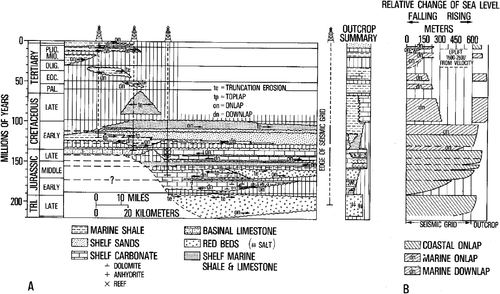Procedure for basin-fill analysis
| Exploring for Oil and Gas Traps | |

| |
| Series | Treatise in Petroleum Geology |
|---|---|
| Part | Predicting the occurrence of oil and gas traps |
| Chapter | Exploring for stratigraphic traps |
| Author | John C. Dolson, Mike S. Bahorich, Rick C. Tobin, Edward A. Beaumont, Louis J. Terlikoski, Michael L. Hendricks |
| Link | Web page |
| Store | AAPG Store |
Objective
The objective of basin-fill analysis is to integrate sequence stratigraphy, geometrical analysis, seismic facies analysis, and lithofacies analysis to produce paleogeographic maps of depositional sequences.
Procedure
Below is a suggested procedure for basin-fill analysis.
- Make a chronostratigraphic chart for the basin.
- Combine sequence stratigraphic interpretations from seismic sections with sequence stratigraphic interpretations from well log cross sections.
- Make paleogeographic maps of depositional sequences.
- Identify the best locations for traps using a combination of paleogeography and sequence stratigraphy.
Chronostratigraphic charts

A chronostratigraphic chart is a correlation chart with geologic time as the Y-axis and distance across the area of interest as the X-axis. A dip-oriented chronostratigraphic chart should be made. But we also should consider making strike-oriented chronostratigraphic charts, depending on the complexity of the stratigraphic section. A chronostratigraphic chart shows the following:[1]
- Apparent geologic time of each sequence and time gaps between sequences
- Relationships of sequences to bounding unconformities, highlighting areas of onlap, downlap, toplap, and truncation
- Relationships and correlation of parasequences to a sequence
- Distribution of facies
Chronostratigraphic charts aid in stratigraphic mapping by showing facies relationships across the basin in terms of time so that paleogeographic maps can be made. They are also useful for structural analysis.
Figure 1 is an example of a chronostratigraphic chart (A) correlated with a chart showing relative sea level changes (B).
Combining well and seismic data
Combining well and seismic data is simple once the correlation between the two is established. Synthetic seismograms establish these correlations. By combining lithofacies with seismic facies, stronger interpretations of the sedimentary section can be made away from well control. Seismic facies allow accurate correlation of lithofacies between wells. Lithofacies allow more detailed interpretation of seismic parameters, such as reflection patterns.
See also
- Basin-fill and trap analysis
- Mapping paleogeography
- Mapping unconformities
- Analyzing depositional sequences for traps
References
- ↑ 1.0 1.1 Mitchum, R. M., P. R. Vail, J. B. Sangree, 1977, Seismic stratigraphy and global changes in sea level, part 6: stratigraphic interpretations of seismic reflection patterns in depositional sequences, in C. E. Payton, ed., Seismic Stratigraphy and Applications to Hydrocarbon Exploration: AAPG Memoir 26, p. 117–133.